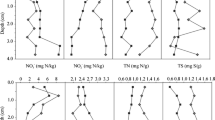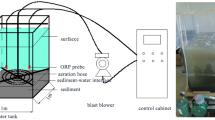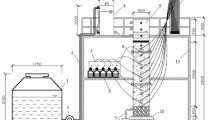Abstract
To demonstrate the variation and affecting factors of dissolved oxygen under different aeration strategies in polluted urban river sediment, simulation systems constructed with collected sediment and in situ overlaying water were aerated up or beneath the sediment-water interface 6 h day−1 for 15 days. The results showed that aeration greatly altered the spatial pattern of DO in overlying water regardless of the way of treatment. Within the first 5 min of aeration, DO in overlying water increases rapidly from 0.86–3.13 mg L−1 to the saturated range of 6.12–8.14 mg L−1. During the first 5 days, aeration to water costed 5 min to reach the highest DO, while aeration to sediment costed 30 min to reach a lower highest level of DO in overlaying water. Analysis showed that DO was significantly negatively correlated with NO2 −-N and COD Mn , suggesting that DO was synergistically consumed by biochemical processes of organic matter degradation and nitrification. Aeration to sediment (ES group) and aeration to water (EW group) differently influenced nitrification and organic matter degradation. After daily aeration treatment, nitrification was the main oxygen-depleting process in EW group, especially after the action of the second stage of nitrification, where organic matter was probably largely degraded during aeration. However, in ES group, DO was consumed by both organic matter oxidation and nitrification processes.







Similar content being viewed by others

Abbreviations
- COD:
-
Chemical oxygen demand
- DO a :
-
The time-weighted average of dissolved oxygen
- DO max :
-
The peak of dissolved oxygen
- DO r :
-
The maximal decline rate of dissolved oxygen
- DTN:
-
Dissolved total nitrogen
- EC:
-
Non-aeration
- ES:
-
Aeration to sediment
- EW:
-
Aeration to water
- LOI:
-
Loss on ignition
- SOD:
-
Sediment oxygen demand
- WOD:
-
Water body oxygen demand
References
Arndt, S., Jørgensen, B. B., LaRowe, D. E., Middelburg, J. J., Pancost, R. D., & Regnier, P. (2013). Quantifying the degradation of organic matter in marine sediments: a review and synthesis. Earth-Science Reviews, 123, 53–86.
Augspurger, T., Keller, A. E., Black, M. C., et al. (2003). Water quality guidance for protection of freshwater mussels (Unionidae) from ammonia exposure. Environmental Toxicology and Chemistry, 22(11), 2569–2575.
Bailey, R. A., Clark, H. M., Ferris, J. P., Krause, S., & Strong, R. L. (2002). Water systems and water treatment. In Chemistry of the Environment (Second Edition) (pp. 415–442). San Diego: Academic Press.
Camargo, J. A., Alonso, A., & Salamanca, A. (2005). Nitrate toxicity to aquatic animals: a review with new data for freshwater invertebrates. Chemosphere, 58(9), 1255–1267.
Camargo, J. A., & Alonso, Á. (2006). Ecological and toxicological effects of inorganic nitrogen pollution in aquatic ecosystems: a global assessment. Environment International, 32(6), 831–849.
Caraco, N., Cole, J., Findlay, S., & Wigand, C. (2006). Vascular plants as engineers of oxygen in aquatic systems. Bioscience, 56, 219–225.
Cébron, A., Berthe, T., & Garnier, J. (2003). Nitrification and Nitrifying Bacteria in the Lower Seine River and Estuary (France). Applied and Environmental Microbiology, 69, 7091–7100.
Chen, W., Ye, S. T., & Zhang, M. X. (2001). Study on the aeration induced reoxygenation in Soochow River. Water & Wastewater Engineering, 27, 7–9. in Chinese, doi: 10.13789/j.cnki.wwe1964.2001.04.003.
Clevinger, C. C., Heath, R. T., & Bade, D. L. (2014). Oxygen use by nitrification in the hypolimnion and sediments of Lake Erie. J Gt Lakes Res, 40, 202–207.
Crompton, B. J. (2005). Effect of land use on sediment oxygen demand dynamics in blackwater streams. Dissertation: University of Georgia.
Dai, M., Guo, X., Zhai, W., Yuan, L., Wang, B., Wang, L., Cai, P., Tang, T., & Cai, W. J. (2006). Oxygen depletion in the upper reach of the Pearl River estuary during a winter drought. Marine Chemistry, 102, 159–169.
Dai, S. G. (2006). Environmental Chemistry (2nd ed., pp. 100–112). Beijing: Higher Education Press.
de Kreuk, M. K., & van Loosdrecht, M. C. (2004). Selection of slow growing organisms as a means for improving aerobic granular sludge stability. Water Science and Technology: a Journal of the International Association on Water Pollution Research, 49(11–12), 9–17.
Doyle, M. C., & Lynch, D. D. (2005). Sediment Oxygen Demand in Lake Ewauna and the Klamath River, Oregon, June 2003. In Scientific Investigations Report (pp. 2005–5228). Reston, Virginia: U.S. Geological Survey.
Emre, A., & Melching, C. S. (2011). Allocation of supplementary aeration stations in the Chicago waterway system for dissolved oxygen improvement. Journal of Environmental Management, 92, 1577–1583.
Gantzer, P. A., Bryant, L. D., & Little, J. C. (2009). Effect of hypolimnetic oxygenation on oxygen depletion rates in two water-supply reservoirs. Water Research, 43, 1700–1710.
Gao, S., Huang, M. S., Wu, L. L., Dai, X. C., & Ruan, Y. Y. (2008). The control test-study of biological purification tank on malodorous river water purification. China Environmental Science, 28, 433–437 (in Chinese).
Grundle, D. S., & Juniper, S. K. (2011). Nitrification from the lower euphotic zone to the sub-oxic waters of a highly productive British Columbia fjord. Marine Chemistry, 126, 173–181.
He, Y., Chen, Y., Zhang, Y., & Huang, M. (2013). Role of Aerated Turbulence in the Fate of Endogenous Nitrogen from Malodorous River Sediments. Environmental Engineering Science, 30, 11–16.
Higashino, M., Gantzer, C. J., & Stefan, H. G. (2004). Unsteady diffusional mass transfer at the sediment/water interface: theory and significance for SOD measurement. Water Research, 38, 1–12.
Hsiao, S. S. Y., Hsu, T. C., Jw, L., Xie, X., Zhang, Y., Lin, J., Wang, H., Yang, J. Y. T., Hsu, S. C., Dai, M., et al. (2014). Nitrification and its oxygen consumption along the turbid Chang Jiang River plume. Biogeosciences, 11, 2083–2098.
König, A., Bachmann, T. T., Metzger, J. W., & Schmid, R. D. (1999). Disposable sensor for measuring the biochemical oxygen demand for nitrification and inhibition of nitrification in wastewater. Applied Microbiology and Biotechnology, 51, 112–117.
Li, J., Zhou, Y. N., He, M., Wang, Y. Y., Wei, S., Garny, K., Neu, T. R., & Horn, H. (2008). Characteristics of aerobic granules from a municipal wastewater treatment plant. Chinese Journal of Applied and Environmental Biology, 5, 640–643 (in Chinese).
Li WJ. Application of aeration technology on pollution treatment of Xingang River in Shanghai. 2007. Dissertation. Donghua University. (in Chinese)
Lu, X. M., & Huang, M. S. (2010). Nitrogen and phosphorus removal and physiological response in aquatic plants under aeration conditions. International journal of Environmental Science and Technology, 7, 665–674.
Matthews, D. A., & Effler, S. W. (2006). Assessment of long-term trends in the oxygen resources of a recovering urban lake, Onondaga Lake, New York. Lake Reserv Manag, 22, 19–32.
Pakulski, J. D., Benner, R., & Amon, R. M. W. (1995). Community metabolism and nutrient cycling in the Mississippi River plume: evidence for intense nitrification at intermediate salinities. Marine Ecology Progress Series, 117, 207–218.
Polak, J. (2004). Nitrification in the Surface Water of the Włocławek Dam Reservoir. The Process Contribution to Biochemical Oxygen Demand (N-BOD). Polish Journal of Environmental Studies, 4, 415–424.
Rabalais, N. N. (2002). Nitrogen in Aquatic Ecosystems. Ambio: A Journal of the Human Environment, 31, 102–112.
Scholes, L., Faulkner, H., Tapsell, S., et al. (2008). Urban rivers as pollutant sinks and sources: a public health concern for recreational river users? Water, Air, and Soil Pollution: Focus, 8(5), 543–553.
Shang, J., Zhang, L., Shi, C., & Fan, C. (2013). Influence of chironomid larvae on oxygen and nitrogen fluxes across the sediment-water interface (Lake Taihu, China). Journal of Environmental Sciences, 25, 978–985.
Sun, C. J., & Zhang, M. X. (2001). Application of aeration technique in river pollution control. Environmental Protection, 11, 12-14+20. in Chinese, doi: 10.14026/j.cnki.0253-9705.2001.04.005.
Utley, B. C., Vellidis, G., Lowrance, R., & Smith, M. C. (2008). Factors affecting sediment oxygen demand dynamics in blackwater streams of Georgia’s Coastal Plain. JAWRA Journal of the American Water Resources Association, 44, 742–753.
Wang, J., Liu, X. D., & Lu, J. (2012). Urban river pollution control and remediation. Procedia Environmental Sciences, 13, 1856–1862.
Wu, H., Li, W., Zhang, J., Li, C., Zhang, J., & Xie, H. (2012). Application of using surface constructed wetland for removal of chemical oxygen demand and ammonium in polluted river water. Desalination and Water Treatment, 44, 142–150.
Xu, X., & Cao, J. S. (2006). Application of river aeration technology in river pollution control of Suzhou area. Water Resources Protection, 22, 30–33 (in Chinese).
Zhang SJ. 2010. Performance of aeration with pure oxygen for quick control of black and odor in river and influencing factors. Dissertation. Tsinghua University. (in Chinese)
Acknowledgments
This study was financially supported by the Natural Science Foundation of Jiangsu Province of China (SBK201321353, BK20140922), the Special Fund for Environment Scientific Research in the Public Interest (201509038), the National Natural Science Foundation of China (41403064), 2015-NIES-Specific Founds for Basic Scientific Research by Central Nonprofit Research Institutes, the Natural Science Foundation of Nantong City (BK2013058), and the Natural Science Foundation of the Jiangsu Higher Education Institutions of China (14KJB610007).
Author information
Authors and Affiliations
Corresponding authors
Ethics declarations
Conflict of Interest
All authors claim that they do not have any actual or potential conflict of interest including any financial, personal, or other relationships with other people or organizations.
Additional information
Bo Liu and Wen-lin Wang contributed equally to this work.
Rights and permissions
About this article
Cite this article
Liu, B., Wang, Wl., Han, Rm. et al. Dynamics of Dissolved Oxygen and the Affecting Factors in Sediment of Polluted Urban Rivers under Aeration Treatment. Water Air Soil Pollut 227, 172 (2016). https://doi.org/10.1007/s11270-016-2869-0
Received:
Accepted:
Published:
DOI: https://doi.org/10.1007/s11270-016-2869-0



